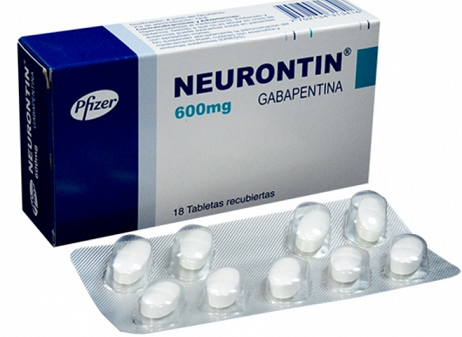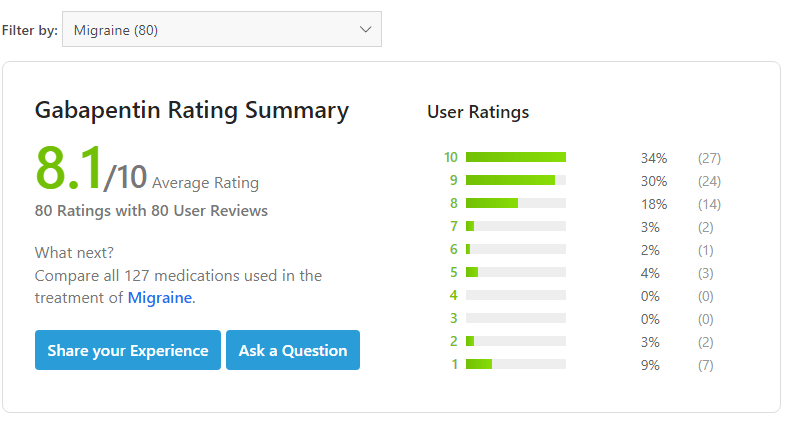Migraine headache is a chronic disease characterized by episodes of disabling head pain associated with other symptoms. Migraine is common in the United States, affecting approx. Twenty-seven million American adults, or 17.1% of women and 5.6% of men.
Persons suffering from episodes of Migraine often treat each episode with medications to provide short-term relief from the attack (acute treatment). Persons who suffer frequent episodes or get inadequate relief from acute treatments may use preventive medicine.
Gabapentin is an anticonvulsant drug which helps control seizures in people. Gabapentin is helpful in post-herpetic neuralgia ( A nerve disease) by changing the way the body senses pain, and gabapentin extended-release tablets are effective in treating Restless Leg Syndrome (RLS).
Gabapentin is also used for treating anxiety. The way gabapentin functions is in a short form, which means it only relieves symptoms rather than treating anxiety disorders totally.
This drug is available on prescription only for its approved action of seizures and nerve pain from the shingle virus. However, it is sometimes used off-label for treating migraine headaches, which means doctors prescribe medicine for medical conditions other than those approved by FDA.
Gabapentin does fit into both categories (Controlled and Non-controlled). You must be aware of why gabapentin is classified as a non-controlled substance. (Goa, K.L. and Sorkin, E.M., 1993)
You must purchase Gabapentin online from a trustworthy telehealth provider in order to be safe. Otherwise, you run the danger of obtaining Gabapentin illicitly, containing possibly harmful or fake ingredients.
How does Gabapentin Prevent Migraines?
Gabapentin is structurally related to Gamma-Aminobutyric acid (GABA), a neurotransmitter of the brain. Its exact mechanism is, however, uncertain. Still, the theory based on the usage of Gabapentin for Migraine is its ability to calm down nerve impulses, which helps decrease migraine pain.
It eases the brain’s electrical activity by blocking calcium channels and settling neurotransmitters. Gabapentin has some efficacy in treating migraine headaches but is not usually prescribed as primary therapy. (Mathew, N.T., Rapoport, A., Saper, J., Magnus, L., Klapper, J., Ramadan, N., Stacey, B. and Tepper, S., 2001)
Gabapentin and Migraines- An off Label Use
When any drug is used for a medical condition other than that approved by the FDA, it is called ‘off-label’ use. Since the FDA monitors the approval and testing of drugs, doctors are allowed to prescribe Gabapentin for migraines for the patient’s benefit.
It is prudent to examine the efficacy of Gabapentin across its many uses to understand the risk-benefit balance. Reviews on off-label indications such as Migraine, fibromyalgia, mental illness, and substance dependence have found modest to no effect on relevant clinical outcomes. (Mack, A., 2003)
Gabapentin Efficacy in Migraine Prophylaxis
Multiple studies were carried out to evaluate the efficacy of Gabapentin in migraine prophylaxis.
Another study was carried out in 2009, based on which gabapentin treatment in patients with Migraine at daily doses of 900-1800 mg resulted in a significant mean reduction of migraine days, pain intensity and the use of acute medications.
Although adverse events occurred in a relatively high percentage, the treatment with Gabapentin was safe and well-tolerated in most patients.
In 2013, the American Academy of Neurology (AAN) stated that there is not enough evidence to recommend Gabapentin for the prevention of Migraine.
A 2016 study proved that Gabapentin is helpful in headache syndromes, but it is still not recommended as primary therapy.
Can Gabapentin Make Migraines Worse?
A significant amount of evidence shows that Gabapentin has a benefit for a majority of primary headache syndromes, including chronic daily headaches. Gabapentin has some efficacy in migraine headaches but not sufficient evidence to suggest prior therapy.
There is also no concrete evidence that it can worsen migraines. It depends on how much the user consumes the medicine, as its side effects can aggravate migraines.
Other Options for the Prevention of Migraine
Various medicines have been studied for migraine prevention, including Antidepressants
- NSAIDs
- Beta-blockers
- Anticonvulsants
- Calcium channel blockers
- Angiotensin blockade agents.
Agents which are used as first-line therapy for migraine include
- Amitriptyline,
- Divalproex (Depakote),
- Propranolol (Inderal),
- Sodium valproate,
- Topiramate (Topamax).
Agents that are probable to be used as second-line therapy for migraine prophylaxis include
- Gabapentin (Neurontin),
- Candesartan (Atacand),
- Naproxen (Naprosyn)
- Naproxen sodium (Anaprox)
- Atenolol (Tenormin)
- Lisinopril (Zestril)
- Fluoxetine (Prozac)
- Metoprolol (Toprol XL)
- Nadolol (Corgard)
- Verapamil (Calan)
Combination of NSAID with other first-line preventive medicine. Amitriptyline can be combined with propranolol or other beta-blockers. This combination is recommended for mixed headaches, i.e. chronic daily headaches and Migraine.
Proper Dose of Gabapentin for Migraines
Gabapentin for migraine prophylaxis should be taken in a prescribed manner and can be taken with or without food. It is available in the form of extended-release tablets, immediate-release tablets and oral solutions.
The dosage for Gabapentin depends on age, overall health and other conditions, and its dose ranges between 300 mg and 3600mg.
Many individuals need only 300-400 mg a day, whereas others may need 3000 mg or more daily. Also, it may take several weeks to show its effect, so it is important to consume medicine for an adequate time.
The side effects of Gabapentin include unusual eye movements, blurred vision, swelling in limbs and feet and ataxia.
It is advised to follow the doctor’s dosage recommendation and consult the medical expert in case of any side effects observed or at the time of weaning off medication.
Conclusion
Many different drugs are effective as migraine preventive treatments. Gabapentin is an anticonvulsant that is not the first-line therapy for Migraine but could be used as second-line therapy and should be prescribed for an adequate period. Thus Gabapentin For Migraines is helpful.


